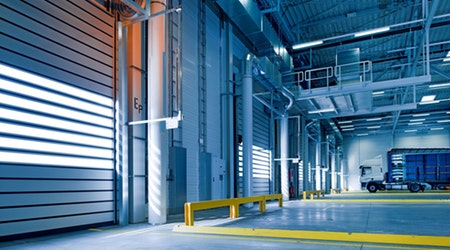IoT Lighting Controls Taking the Lead in Efficient, Green Applications
Part 2 of a 4-part article exploring the current reality and future promise of Building Internet of Things for facilities
A handful of lighting control system manufacturers already demonstrate this trend today, with an unexpectedly IoT angle. Their architectures consist of a sensor per light fixture, which creates a very dense array of measured light level, temperature, and occupancy, for the original purpose of superior lighting control. They discovered that the sensor density allowed us to derive an approximate measure of space utilization using algorithms tied to the multiple sensors in an area. Coupled with software to reveal the trends over time, this unanticipated application of lighting control sensors is enabling facility managers to make better space-planning decisions based on the measured use. This is both efficient and green. Manufacturers have recently begun selling sensor networks without any lighting controls for customers interested only in the space-planning application. This application was fundamentally enabled by a low cost per sensor, which for the first time allows such sensor density in practical installations.
For buildings, we must strive to adopt IoT solutions that permit interoperability with other products and manufacturers. Take two hypothetical environmental monitoring products as examples that show the difference between true interoperability and not. The first product creates a wireless mesh network between sensors and a gateway, but the sensors use a proprietary radio and messaging protocol, and the gateway pushes the sensor data to the manufacturer’s cloud, where it gets cleaned, normalized, and displayed in browser-based dashboard graphics. The second product uses a published open protocol over a standards-based wireless network. The data is available locally from the gateway via common BAS open protocols such as BACnet/IP, and the manufacturer-created application program interfaces (APIs) permit more sophisticated interaction. (APIs are a set of functions other software developers can use to access data and functionality.) The second product is a better option because sensors from third-party manufacturers could be deployed within the mesh, other systems in the building could directly react to the measured data if desired, and the data could be incorporated into software solutions along with other systems in the building.
One hopeful promise of the Building IoT is to permit decoupling of software applications from the sensing hardware and networks. The decoupling is born from necessity, as highly specialized manufacturers with very narrow product offerings seek larger market share by permitting other novel use-cases of their products. To enable others to leverage their products, they include easy-to-use APIs.
For buildings, the last decade has been marked by a slow but steady shift toward a similar mindset. The Constructions Specification Institute, the authority on the organization of specs commonly used in commercial construction, created a dedicated spec division in 2004 to address integrated automation systems. This Integrated Automation Systems division (Division 25) is distinct from the customary Mechanical, Electrical, Plumbing, and related building services divisions.
This division is being used to define a scope of work for a specialist system integrator and to provide software and special programming skills to link together the various control components of the other building systems into a unified intelligent building software platform. The system integrators are typically adept at bringing together various best-in-class software applications that meet the unique needs of a project or owner. For example, a project may desire a chiller plant optimization application, an in-depth energy analytics application for the owner’s energy manager, and occupant-facing performance dashboards to provide feedback on occupant behavioral change.
It is quite likely that with the excitement and money behind IoT concepts, and with a wealth of new IoT hardware coming to market, the trend toward software decoupled from hardware will accelerate, and the more traditional building control system manufacturers will feel obligated to create more flexibility in their products to facilitate this trend.
New Security Risks
When devices are connected to a network, new security risks are introduced. The data communicated across the network must be handled securely, because it may reveal sensitive or private facts, and others who may rely on the data must trust that it is accurate. Software applications must be safe from malicious actions, as well as accidental but non-malicious misuse. The new equipment and networks must not permit new “back doors” into other unrelated but interconnected devices and networks. These are but a few of the critical concerns around security.
Unfortunately, appropriate security is often woefully lacking in the IoT devices coming to market today, both in the commercial building space as well as from other industries and sectors. With the current “gold rush” to deliver products that are first to market, security often appears to be an afterthought. Whether the IoT devices are medical, industrial, consumer, or commercial building devices, security will be forced to the forefront in reaction to incidents. In our commercial buildings, we must remain aware about the need for security and avoid early adoption of products and solutions that are not yet properly secured.
Many of the things in our buildings today could rightly be called IoT, even if we tend to use less glamorous terminology such as BAS, EMS, or BMS. As other industries rush to adopt newer and better ways to gain efficiency by connecting more devices to networks, our buildings will naturally follow suit.
When the IoT has fully transformed our commercial buildings, we can expect to see many times more environmental sensing devices, including devices that locate people, count people, and measure every aspect of how people interact with their commercial spaces. These devices will be relatively inexpensive to buy and install in bulk. And we can expect an explosion in the development of low-cost applications that can be installed and used directly by the building operators, owners, and occupants on a whim. The applications will leverage not just the building system data, but also a wealth of other systems and data from diverse sources, to solve problems we haven’t imagined yet. These techniques will allow facility managers to run their buildings on less energy, operate and maintain them more effectively, provide adequate security, and enhance the occupant experience by creating a responsive environment targeted to the specific preferences of each occupant.
Robert Knight is senior associate, controls engineer, for Environmental Systems Design. He is a leading systems integration engineer, specializing in difficult integrations. Knight is proficient in writing sequences of operation for complex central plant and built-up systems.
Related Topics:















